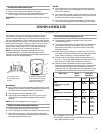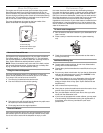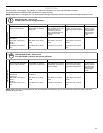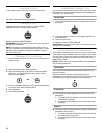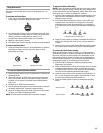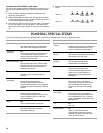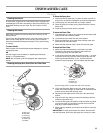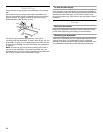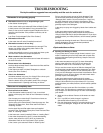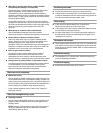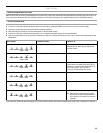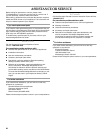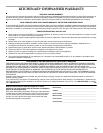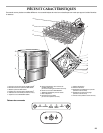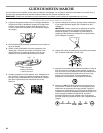
17
TROUBLESHOOTING
First try the solutions suggested here and possibly avoid the cost of a service call...
Dishwasher is not operating properly
■ Dishwasher does not run or stops during a cycle
Is the drawer closed tightly?
Is the correct wash cycle selected? Refer to“Wash Cycles.”
Is there power to the dishwasher? Has a household fuse
blown, or has a circuit breaker tripped? Replace the fuse or
reset the circuit breaker. If the problem continues, call an
electrician.
Is an Error Code indicated? (See “Error Codes.”)
■ Dishwasher will not fill
Is the water shut-off valve (if installed) turned on?
■ Dishwasher seems to run too long
Is the water supplied to the dishwasher hot enough? The
drawer runs longer while heating water. Refer to the
“Performance Tips” section.
A delay automatically occurs in some wash and rinse cycles
until the water reaches the proper temperature.
■ Water remains in the dishwasher
Is the cycle complete? A small amount of water will remain in
the drain filter area.
■ Excess water in the dishwasher
Are there blocked drain filters? Clean the drain filter and filter
plate. (See “Cleaning.”)
Is the drain hose bent or kinked? Straighten or unblock
hoses. (See “Error Codes.”)
■ Odor in the dishwasher
Are dishes washed only every 2 or 3 days? Run a rinse cycle
once or twice a day until you have a full load.
Does the drawer have a new plastic smell? Run a vinegar
rinse as described in “Spotting and filming on dishes.”
Dishes are not completely clean
■ Food soil left on the dishes
Is the dishwasher loaded correctly? If not, it can block
rotation of the spray arm. Refer to the “Dishwasher Loading”
section.
Can the spray arm rotate freely? Check that no items are
obstructing the spray arm path.
Are the spray arm holes blocked? Clean the spray arm. See
“Cleaning the Spray Arm, Drain Filter and Filter Plate” in
“Cleaning” section.
Are the drain filter and filter plate clean and installed
correctly? See “Cleaning the Spray Arm, Drain Filter and Filter
Plate” in “Cleaning” section.
Is the base rack correctly installed? Refer to “Loading Rack.”
Is the water temperature too low? For best dishwashing
results, water should be 120°F (49°C) as it enters the
dishwasher. Refer to the “Performance Tips” section.
Is the correct cycle selected? Refer to “Wash Cycles.”
Did you use the correct amount of fresh detergent? Use
recommended dishwasher detergents only. Refer to the
“Detergent Use” section. Do not use less than 1 tsp (5 mL)
per load. Detergent must be fresh to be effective. Store
detergent in a cool, dry area. Heavy soil and/or hard water
generally require extra detergent.
Is the pump or spray arm clogged by labels from bottles and
cans?
Is the home water pressure high enough for proper
dishwasher filling? Home water pressure should be 20 to
120 psi (138 to 828 kPa) for proper dishwasher fill. If you have
questions about your water pressure, call a licensed, qualified
plumber.
Are high suds slowing the wash arm? Do not use soap or
laundry detergents. Use recommended powdered
dishwasher detergents only.
Spots and stains on dishes
■ Spotting and filming on dishes
Is your water hard or is there a high mineral content in your
water? Conditioning the final rinse water with a liquid rinse
aid helps eliminate spotting and filming. Keep the rinse aid
dispenser filled.
Is the water temperature too low? For best dishwashing
results, water should be 120°F (49°C) as it enters the
dishwasher. Refer to the “Performance Tips” section.
Did you use the correct amount of effective detergent? Use
recommended powdered dishwasher detergents only. Refer
to the “Detergent Use” section. Do not use less than 1 tsp
(5 mL) per load. Detergent must be fresh to be effective. Store
detergent in a cool, dry area. Heavy soil and/or hard water
generally require extra detergent.
Is the home water pressure high enough for proper
dishwasher filling? Home water pressure should be 20 to
120 psi (138 to 828 kPa) for proper drawer fill. If you have
questions about your water pressure, call a licensed, qualified
plumber.
NOTE: To remove spots and film from dishes, try a white
vinegar rinse. This procedure is intended for occasional use
only. Vinegar is an acid and using it too often could damage
your drawer.
1. Wash and rinse dishes. Remove all silverware or metal
items.
2. Put 1 cup (250 mL) white vinegar in a glass or
dishwasher-safe measuring cup on the rack.
3. Run the dishwasher through a complete washing cycle.
Do not use detergent. Vinegar will mix with the wash
water.



